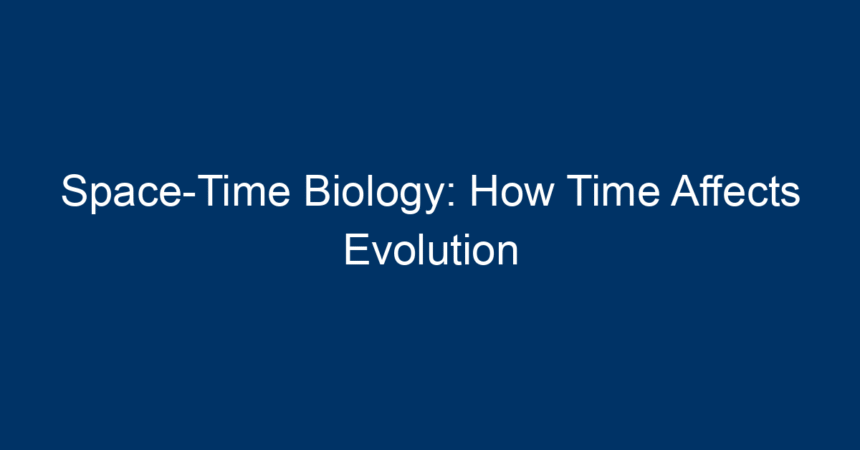Introduction
In the quest to understand the intricacies of life, one revolutionary concept has emerged: space-time biology. This fascinating field combines principles of physics and biology to explore how time influences the evolutionary processes that shape life on Earth. From the slow dance of plate tectonics to the rapid mutations driven by environmental pressures, time plays a pivotal role in the evolution of species. In this article, we’ll delve deep into space-time biology, uncovering how the very fabric of time impacts evolution, adaptation, and the future of life on our planet.
The Concept of Space-Time in Biology
What is Space-Time Biology?
Space-time biology seeks to integrate the dimensions of space and time into biological understanding. Influenced by Einstein’s theories, this approach considers how organisms grow, reproduce, and evolve not just in a static environment but in a continuously changing temporal context. By examining life through this lens, scientists can better comprehend how evolutionary changes happen over varying scales of time.
The Interplay of Time and Space
Time and space are interconnected. In everyday terms, we often think of time as a linear progression and space as a separate entity. However, in space-time biology, they are part of a continuum. Evolutionary adaptations do not occur in isolation; they are influenced by geographic changes, climate shifts, and even cosmic events. These influences over time create a complex web where the evolution of life is not merely a biological phenomenon but also a physical one.
The Role of Time in Evolution
Geological Time Scales
One of the most significant aspects of space-time biology is understanding geological time scales. The Earth’s history spans billions of years, and life has had to adapt to a multitude of changes during this immense period. Plate tectonics, which shifts continents and alters sea levels, has caused dramatic changes in habitats, driving species to evolve or go extinct.
For instance, the separation of continents has led to divergent evolution, as seen in species found only on isolated islands. Such developments highlight the role of time as a facilitator of evolutionary adaptation through geographical changes.
The Micro-Evolutionary Changes
While geological changes take millions of years, evolution can also occur at a much faster rate. Micro-evolutionary changes—small genetic alterations within a species—can occur within human-relevant timescales. These adaptations often arise in response to environmental stresses, such as climate change or habitat destruction.
For example, the peppered moth underwent a significant color change during the Industrial Revolution, which served as a classic example of natural selection in action. Over a few generations, darker moths became more prevalent, showcasing how quickly evolution can respond to changes merely tens of years or decades apart.
Cosmic Influences on Evolution
Extraterrestrial Time Events
In exploring space-time biology, it’s crucial to consider cosmic influences on Earth. Events such as asteroid impacts and solar flares have the potential to induce rapid evolutionary pressures. The extinction of dinosaurs, attributed to a massive asteroid impact, exemplifies how a single moment in time can reshape the trajectory of life on Earth.
These cosmic events can lead to mass extinctions, but they also pave the way for new species to thrive in the absence of dominant competitors. Understanding these influences adds another layer to the study of space-time biology, showing that evolution is not just a matter of biology but is deeply intertwined with celestial phenomena.
Time as a Selective Pressure
In addition to geological and cosmic influences, temporal factors can serve as selective pressures. The seasons, for instance, induce changes in animal behavior and reproductive cycles. Organisms that can adapt their life cycles to align with seasonal variations are more likely to survive and reproduce successfully.
For example, some species blossom earlier in seasons, while others may hibernate to cope with food scarcity during winter. Such adaptations underline the importance of time in the survival of various species, emphasizing the need for a comprehensive understanding of space-time biology.
The Future of Space-Time Biology
Implications for Conservation
With climate change accelerating environmental shifts, the understanding of space-time biology becomes vital in crafting conservation strategies. Conservationists can utilize this knowledge to predict how species may react to changing environments over different time scales. For instance, understanding migratory patterns can help in creating wildlife corridors that accommodate the movement of species in response to climate change.
Advancements in Biotechnology
Moreover, advancements in biotechnology are paving the way for exploring evolutionary adaptations in new dimensions. Techniques like CRISPR can enable scientists to manipulate genes and observe changes over time, bridging the gap between time and evolutionary biology. This temporal manipulation could offer unprecedented insights into how organisms adapt and evolve in real-time.
Actionable Insights
Embrace a Multi-Disciplinary Approach
To fully leverage the insights offered by space-time biology, it’s essential to adopt a multi-disciplinary approach. Integrating knowledge from physics, biology, geology, and ecology can provide a holistic understanding of how time influences evolutionary processes.
Innovate in Conservation Strategies
Conservationists should utilize findings from space-time biology to innovate strategies that are adaptable to the fast-paced changes induced by human activities and climate change. By understanding species’ temporal reactions to stressors, more effective conservation efforts can be designed.
Engage in Public Awareness
Raising public awareness about the principles of space-time biology can foster appreciation for the intricate dynamics of evolution. Educational programs that highlight how time shapes life can motivate future generations to participate in conservation efforts and promote sustainable practices.
Conclusion
In conclusion, space-time biology offers a groundbreaking perspective on the evolutionary journey of life on Earth. By interpreting biological processes through the lens of time and space, we gain crucial insights into how species adapt to their changing environments. As we face unprecedented global challenges, this understanding becomes pivotal in guiding conservation efforts and ensuring a sustainable future for the myriad forms of life that share our planet. Embracing the complex dance of evolution within the vast expanse of time can empower us to navigate the future wisely—after all, the story of life is written in the very fabric of space-time itself.




